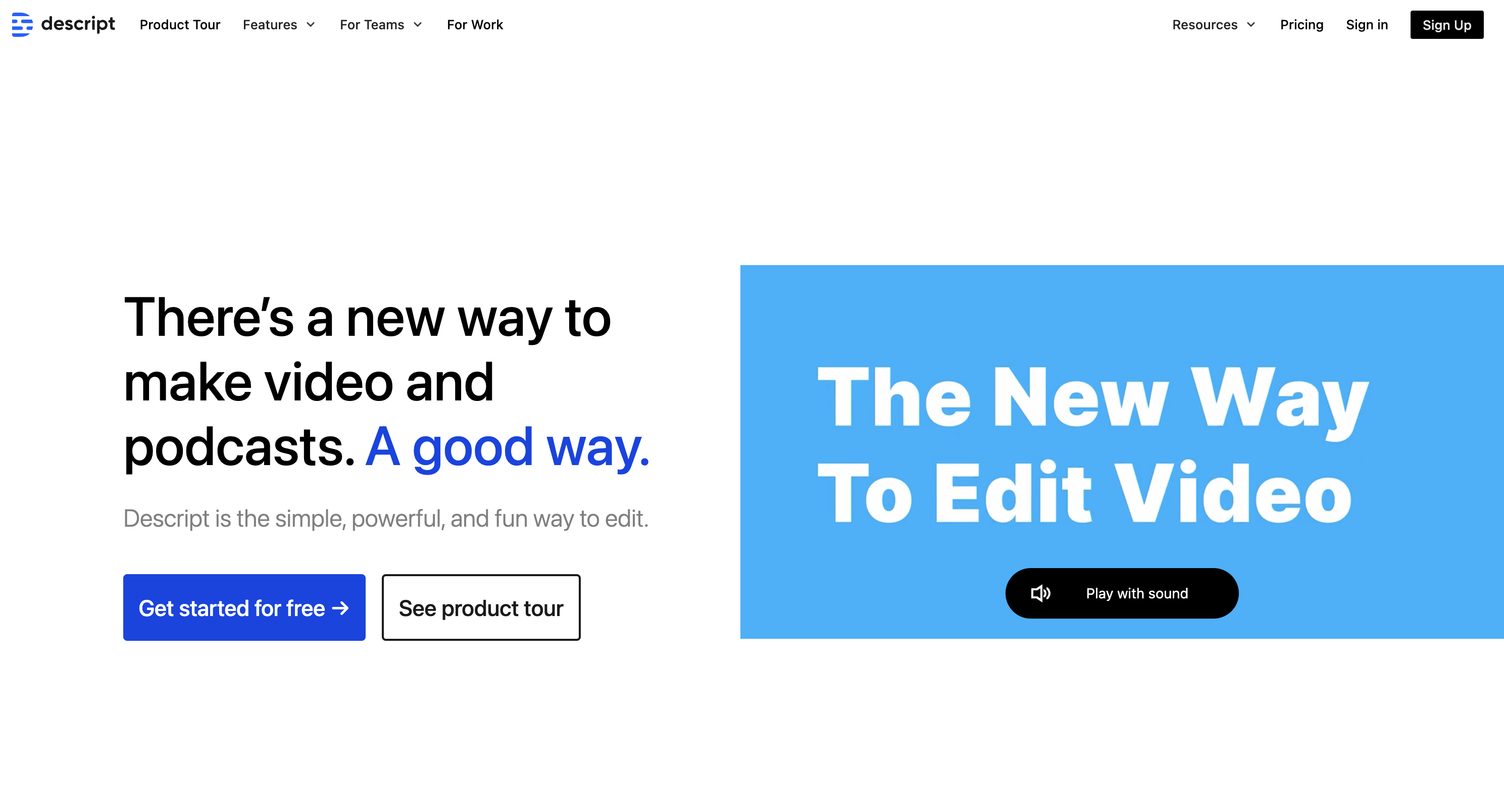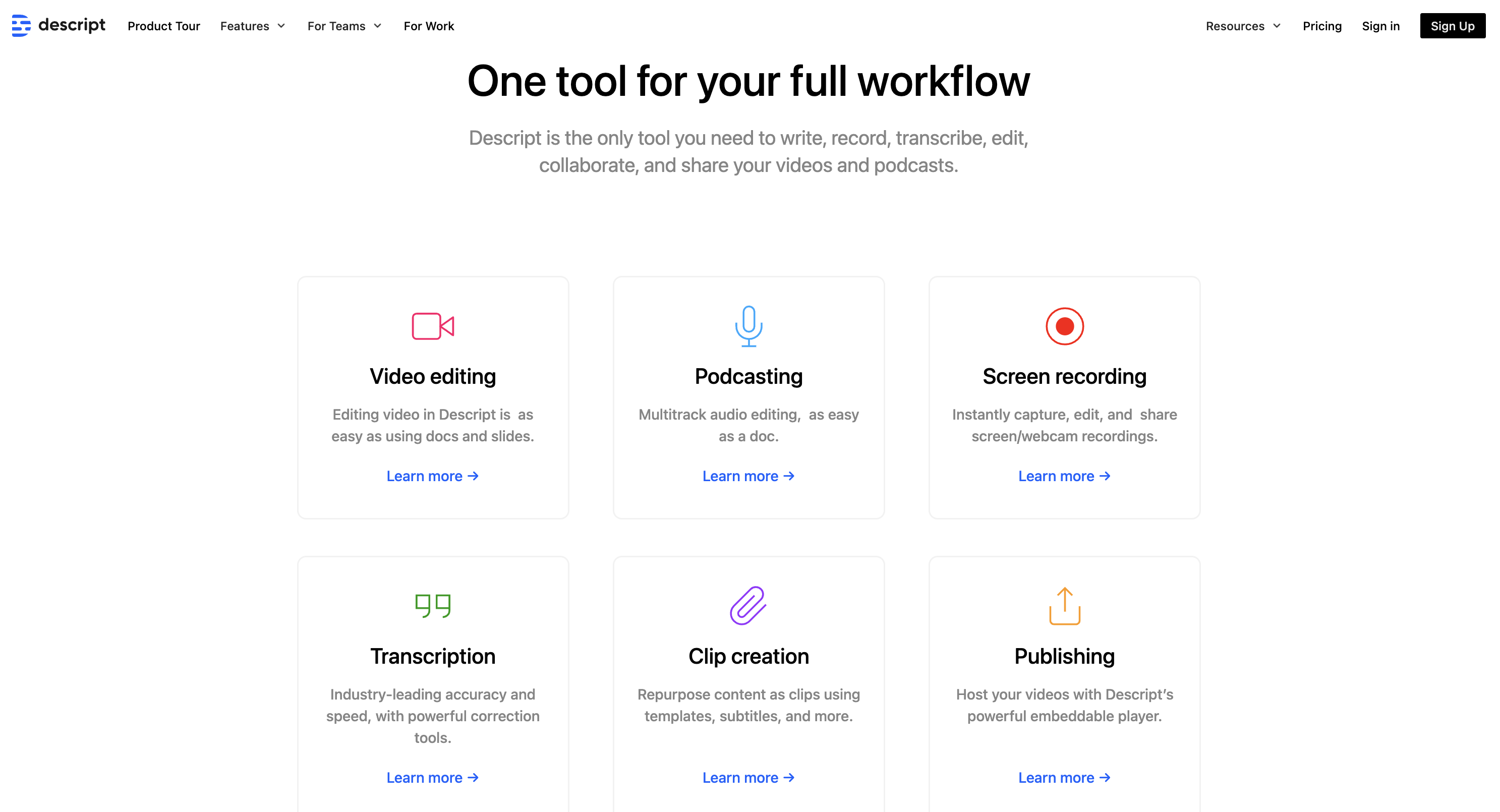Tired of spending hours wrestling with complex audio and video editing software? In a world where content is king, time is your most precious resource. Descript promises to streamline your workflow with its all-in-one editing magic. But in 2025, does it live up to the hype? This in-depth review will cut through the noise, exploring its features, pricing, pros, cons, and alternatives, so you can make an informed decision.
Introduction
In 2025, content isn’t just king – it’s the entire kingdom. Podcasts, videos, and engaging social media posts are the currency of success online. But behind every polished piece of content lies the often-tedious world of editing. That’s where Descript steps in, promising to revolutionize how we work with audio, video, and even text. It’s more than just a transcription tool or a video editor; it positions itself as an all-in-one content creation powerhouse. Yet, as with any powerful tool, the question remains: is Descript truly worth the investment in 2025? This in-depth review aims to answer that, providing an up-to-date and unbiased look at its features, pricing, strengths, weaknesses, and where it stands in a competitive market.
What is Descript?

Descript is a unique software platform designed to simplify and streamline the audio and video editing process. Its core functions include:
- Automated Transcription: Descript quickly and accurately transcribes audio and video files into editable text.
- Intuitive Editing: Edit audio and video content by directly editing the transcript, similar to working with a word document.
- Overdub (Voice Cloning): Replicate your voice or create entirely new voices using Descript’s text-to-speech technology.
- Screen Recording: Capture your screen along with audio, perfect for tutorials and presentations.
- Collaboration Features: Collaborate with others in real-time on projects, with comments and editing permissions.
Target Audience
Descript is popular among a wide range of content creators, including:
- Podcasters: Streamline podcast production, from editing out mistakes to creating detailed show notes.
- Video Creators: Edit YouTube videos, vlogs, and other video content with ease.
- Marketers: Create engaging social media videos and marketing content quickly.
- Educators and Students: Build course material, presentations, and take accessible notes.
Key Features in 2025

- Transcription Accuracy & Speed
- Descript continues to lead in transcription accuracy, likely boasting even faster performance in 2025.
- Expect expanded support for accents, specific dialects, and technical vocabulary.
- Potential for real-time or near real-time transcription for live events or interviews.
- Editing Tools & Interface
- Descript’s core strength lies in its intuitive editing. Text-based editing is likely to remain central.
- More refined audio editing tools, possibly rivaling dedicated audio software in some areas.
- Streamlined interface for even smoother user experience across devices.
- Overdub (Voice Cloning)
- Overdub is a powerful feature and could become even more realistic by 2025.
- Finer control over voice inflections and ability to create multiple voice profiles.
- Potential ethical considerations will likely lead to enhanced transparency features on overdubbed content.
- Collaboration Features
- Real-time collaboration is already strong but expect seamless integration with popular project management tools.
- More granular control over permissions and revision history for larger teams.
- Screen Recording and Video Editing
- While basic video editing exists, this is an area for potential expansion by 2025.
- Advanced features like transitions, effects, and color grading could be integrated.
- Simplified video exporting optimized for various social media formats.
- Integrations
- Expect deeper integrations with popular content creation and storage platforms.
- Direct publishing options to social media, podcast hosting services, and video platforms.
Important Note: Some of these features may be speculative to an extent. The pace of innovation at Descript will play a big role in the exact features available by 2025.
Pricing (2025)
Descript typically offers the following tiers. Assume potential price changes and feature adjustments by 2025:
- Free
- Limited transcription hours per month.
- Basic editing tools.
- Limited project storage.
- Watermarked video exports.
- Creator
- Increased transcription hours.
- More advanced editing tools (filler word removal, Overdub vocabulary expansion).
- Larger project storage.
- High-resolution unwatermarked video exports.
- Pro
- Significantly more transcription hours or possibly unlimited transcription.
- Full suite of editing tools, including advanced filler word removal.
- Even larger project storage.
- Collaboration features may be expanded.
- Potential for stock media library access.
- Enterprise
- Primarily for large teams and organizations.
- Unlimited features.
- Custom onboarding and support.
- Potential for volume discounts.
Value Assessment
To decide if Descript is worth the cost, consider these factors:
- Feature Needs: Do you need advanced features like Overdub, extensive collaboration, or high-volume transcription?
- Time Savings: How much time does Descript save you compared to traditional editing methods? Value your time accordingly.
- Alternative Costs: Compare Descript’s pricing to the combined expense of separate transcription, editing, and collaboration tools.
- Use Frequency: Casual users might find the Free plan sufficient, while daily users will likely find Creator or Pro plans more cost-effective.
Important: Always check Descript’s official website for the most up-to-date pricing (https://www.descript.com/).
Pros of Descript in 2025
- Ease of Use: Descript will likely maintain its reputation for having the most intuitive editing interface on the market. This significantly lowers the barrier to entry for content creators at all skill levels.
- Time-Saving Efficiency: Everything about Descript is designed to streamline your workflow. From quick transcriptions to text-based editing, features are made to cut down production time, letting you create more content faster.
- Innovative Features: Descript constantly pushes boundaries with features like Overdub. Expect even more groundbreaking AI-powered tools to simplify audio and video creation in 2025.
- Accuracy: Even now, Descript’s transcription is highly accurate. This likely improves further by 2025, giving you a reliable base for editing, and making your audio searchable even within the platform.
- Multi-Purpose Workhorse: Descript is no longer just for podcasters. The expanded features make it a solid choice for video editors, marketers, educators, and anyone working with audio and video content.
- Cloud-Based Flexibility: Edit projects from anywhere. Changes are saved in real-time, great for teams or when you need to switch devices.
Additional Pros to Consider:
- Regular Updates: Descript consistently adds new features and improves existing ones.
- Strong Community and Support: Helpful user forums and responsive customer support.
Cons of Descript in 2025
- Learning Curve (for advanced tools): While the core editing is intuitive, some advanced features like Overdub and in-depth audio manipulation might take time to master fully.
- Cost for Power Users: The Pro tier, offering unlimited transcription and the full suite of features, could be an investment for some content creators.
- Limitations vs. Specialized Software: Descript is incredibly versatile, but professionals in certain niches might still prefer dedicated software. Audio engineers might miss the precision of DAWs, and video editors might need the advanced effects of programs like Premiere Pro.
- Potential for Feature Bloat: As Descript adds tools, there’s a risk of the interface becoming less streamlined, though they’ve done a great job of balancing this so far.
- Dependence on Internet Connectivity: Cloud-based tools rely on a stable internet connection, which can sometimes be an issue depending on your location or work setup.
Important Considerations
- Descript’s free and lower-priced tiers offer great value, mitigating the higher cost for some.
- Descript’s core focus is on ease and streamlining. It can often achieve 80% of what specialized software does, in a much faster timeframe.
Top Descript Alternatives
- Otter.ai
- Pricing: Offers free and paid plans (Pro, Business, Enterprise)
- Features: Primarily a transcription service with powerful search and speaker identification. Some editing capabilities are present, but the focus is on text-based transcription.
- Target Audience: Ideal for note-taking, meeting transcriptions, and those who prioritize accurate transcripts over extensive editing features.
- Adobe Audition
- Pricing: Subscription-based, part of the Adobe Creative Cloud suite.
- Features: A true professional audio editing powerhouse with advanced tools for mixing, mastering, and sound design.
- Target Audience: Audio engineers, musicians, and those who need fine-grained control over every aspect of sound editing. Requires a significant learning curve.
- Audacity
- Pricing: Free and open-source.
- Features: Comprehensive audio editing software with a wide range of tools. Traditional interface but very capable for the price.
- Target Audience: Great for budget-conscious users needing traditional audio editing features. Less beginner-friendly than Descript.
- Riverside.fm
- Pricing: Various tiers based on recording hours and video quality.
- Features: Focuses on remote recording and editing of podcasts and interviews. Includes transcription, separate track recording, and some editing tools.
- Target Audience: Podcasters specifically, especially those who frequently record interviews or work with remote guests.
- ScreenApp.io
- Pricing: Free and paid tiers (Creator and Business)
- Feature Focus: Screen recording with a strong emphasis on video editing features like annotations, overlays, and transitions. Overdub voice cloning is included as a feature.
- Target Audience: Perfect for tutorials, demonstrations, video-based presentations, and content creators who prioritize screen capture and editing efficiency.
Remember: The best alternative for you depends heavily on your specific needs and priorities. Consider the trade-offs between features, pricing, ease-of-use, and your target content format.
Conclusion
Descript continues to evolve as a remarkably powerful all-in-one tool for audio and video content creation. Its ease of use, innovative features, and time-saving potential make it stand out in a crowded market. While the higher tiers may be an investment for some, the free and Creator plans offer excellent value for trying out Descript’s core strengths.
Overall Recommendation:
- If you prioritize speed, convenience, and a streamlined workflow: Descript is likely an excellent choice for your content creation needs.
- If you require specialized tools in audio or video editing: Consider augmenting Descript with dedicated software or exploring more focused alternatives.
Descript is truly one of those tools that’s best experienced firsthand. Give the free plan a try and see how it transforms your audio and video editing process. Have you used Descript or similar tools? Share your experiences in the comments below, and let’s learn from each other!






